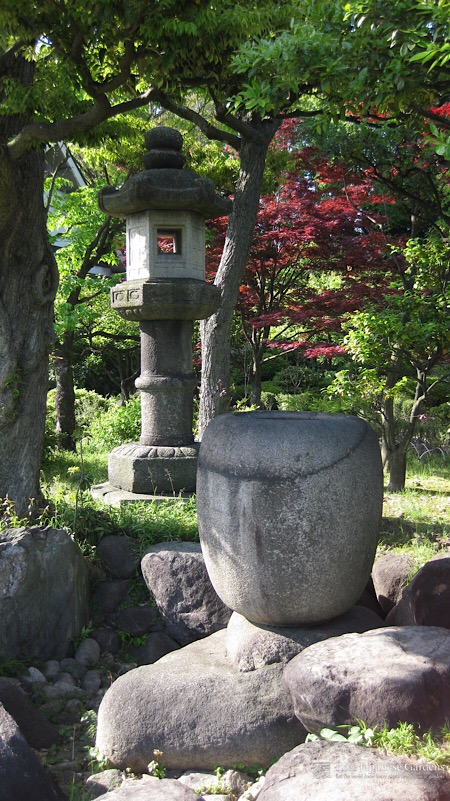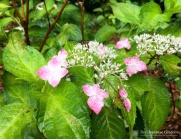[Tour Report] Kiyosumi Garden
Hi there!
If you follow us on Social Media, you will know that I had my Kiyosumi garden tour on June 15. And I did it in the pouring rain!
And do you know? We had a lot of fun!
It seems that the weather made some people not to come and I ended up with only three participants but one also brought her lovely daughter.
 Together we explored the history of the garden under a roof before we stepped outside into the rain. Every one of us was well prepared for the weather with raincoats and umbrellas, and only one of us had no rain boots but could be convinced that Japanese rain boots are the greatest and buying them is very well spent money in preparation of the rainy season.
Together we explored the history of the garden under a roof before we stepped outside into the rain. Every one of us was well prepared for the weather with raincoats and umbrellas, and only one of us had no rain boots but could be convinced that Japanese rain boots are the greatest and buying them is very well spent money in preparation of the rainy season.
The route brought us to one of the most expensive and outstanding rocks of the whole garden: a red rock from Niigata prefecture and its small brother. Then we headed over to the pond to say “hi” to the many turtles and koi carps.
 Next stop was the old tea garden. During the Meiji period there stood a Japanese style residence where now the Taisho Kinenkan is located. The tea garden was to its right side.
Next stop was the old tea garden. During the Meiji period there stood a Japanese style residence where now the Taisho Kinenkan is located. The tea garden was to its right side.
Here we found an outstanding rock – a mizubore ishi – with a natural carved hole to keep water and function as a hand washing basin.
The big natsume gata chozubachi and the kasuga gata stone lantern of the former tea garden are also still there.
On we went to the middle island to explore the bridge leading there and how it was transformed over time. Around 2014 it was reconstructed to its original form. On the middle island are also the remains of a drum-shaped lantern which‘s shape originated in China. What I also told my participants was a story about the Japanese wax tree and mosquitoes. The Japanese wax tree on the middle island is famous for its flaming red autumn color.
 Now we rushed over to the large lawn area with the irises. On our way, we passed the Mount Fuji and the big waterfall setting, I talked about it later.
Now we rushed over to the large lawn area with the irises. On our way, we passed the Mount Fuji and the big waterfall setting, I talked about it later.
A surprise welcomed us on the lawn area: a small truck functioning as a coffee stand! It was only the second time they went there to sell coffee and other beverages. How lucky we were! Some of us explored the irises while the others already went to the truck to get a hot drink and settle under the big roof next to it.
I bought myself hot cocoa (yes, no coffee!) and spent some time talking about Japanese irises and answering questions.
After our short break and when we felt warm again, we continued our tour and I explained the Mount Fuji and how it might look like in the future, and the amazing dry waterfall setting, which was once one of the main focal points within the garden.
 Our route brought us close to the tea house Ryotei, which is the only remaining structure in the garden. All the others were destroyed during the earthquake of 1923 or during the air raids in 1945. The tea house can be rented, but it is not possible to visit it when it isn‘t occupied.
Our route brought us close to the tea house Ryotei, which is the only remaining structure in the garden. All the others were destroyed during the earthquake of 1923 or during the air raids in 1945. The tea house can be rented, but it is not possible to visit it when it isn‘t occupied.
Now the tour was already close to its end. We climbed a small hill where the umbrella hut was once located. This was damaged during the earthquake of 2011 and will not be replaced. You will find pictures of it still on the official pamphlet if you are curious how it looked like. From here we had the best view on one of the other islands, the Pine Island.
So close to the entrance of the garden our little visitor heard her home calling and she and her mother already said goodbye. This was ok because there wasn‘t much more to talk about. We had a small stop at the zigzag bridge where I pointed out why it may have this shape and we looked over to Mount Fuji on the other side of the garden.
Both of my other participants agreed that Mount Fuji in its original state – without trees – will have been impressive and a focal point, while it is now, with all the trees on top, easily overseen.
 Before we reached the end of the tour we crossed the Oisowatari, huge rocks functioning as stepping stones in the pond and I shared why I feel a little insecure on them since I heard how they were fixed to the ground..
Before we reached the end of the tour we crossed the Oisowatari, huge rocks functioning as stepping stones in the pond and I shared why I feel a little insecure on them since I heard how they were fixed to the ground..
 Now one member returned home and I ate lunch in the Taisho Kinenkan with the last member. It is not for long that the staff there serves hot and cold soba noodles and they were so good! After a nice chat we parted and she headed home while I had a short stop at the Edo-Fukagawa Museum.
Now one member returned home and I ate lunch in the Taisho Kinenkan with the last member. It is not for long that the staff there serves hot and cold soba noodles and they were so good! After a nice chat we parted and she headed home while I had a short stop at the Edo-Fukagawa Museum.
I am happy that all of the participants didn’t fell into a bad mood over the weather and we were able to enjoy and study the garden together. I believe we had a lot of fun and all of them learned new things about Japanese gardens in general and the Kiyosumi garden in detail.
The next public tour will happen in autumn (maybe before the autumn leaf color hype starts) and I hope to meet you there!
If you want to join our next public garden tour and don’t want to miss it, join our Newsletter!
